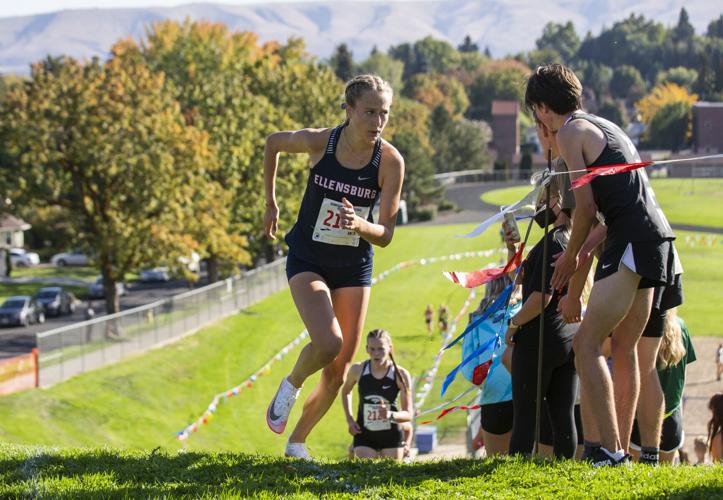Casual visitors know Franklin Park’s terraces as a scenic backdrop for the park’s myriad activities and a winter sliding playground for the young and the reckless.
Sunfair Invitational runners, however, dread the terraces as a portent of anaerobic agony leading up to the first mile of the three-mile course. The imposing climb looms ominously in the minds and race strategies of the young athletes as they navigate the park’s ups, downs and brief flat leading to the climb.
The assorted spectators, coaches, teammates, parents and the curious at the Sunfair meet savor the one-mile mark — “split” in competitive running parlance — as a solid gauge of the runners’ standing one-third of the way through the races, which will stage their 49th edition on Saturday.
And coming at the highest elevation of the course, the one-mile split is arguably the best place to watch the race unfold. This aspect is not lost on the assembly of spectators, including the lucky individual who gets to operate the one-mile digital split clock.
For the past dozen years or so, that lucky individual has been me.
In the context of continental land mass, the terraces are neither expansive nor extensive. The eight terraces, each of equal length, comprise about 40 yards total on a roughly 30 percent overall incline. The elevation gain over that stretch is about 35 to 40 feet. The strongest and fastest of the young legs traverse them in 20 seconds or less.

High school runners compete in the Sunfair Invitational on Saturday, Sept. 29, 2018, at Franklin Park in Yakima, Wash.
But the terraces render a runner breathless by the top, even those who back off their pace for the duration. Once at the top, competitors must immediately reorient their stride, cadence, breathing and overall running form for the much-welcome flat and downhill stretch that awaits. Coaches who line the course there are quick with such reminders, sometimes quite vocally. They are coaches, after all.
The one-mile clock offers useful information to the assembled throng but isn’t the official time, which is kept electronically. That said, the operator strives to start it just as the gun goes off at the starting line, which is about 250 yards down the hill near the pickleball courts.
By total happenstance, the one-mile mark offers a clear view of the starting line and enables the operator to start the clock "on the smoke" of the starting gun — to throw in more running parlance. Recall from grade-school science that light travels faster than sound. How many seconds does that smoke/sound difference entail at Sunfair? A mere fraction of one. But still … .
Yes, strange things can happen at a meet that involves hundreds of athletes and various kinds of equipment. Athletes who conquer the terrace in an anaerobic disorientation ("brain-dead" is a favored coaching description) have been known to try to turn around and drop straight downhill to where they came from. Nope, turn left — the gradual downhill eventually arrives. Spectators can inattentively wander onto the course. Runners occasionally take a wrong turn and require redirection.
Then there are equipment glitches, such as when the battery pack powering the clock went dead in the year that longtime Hard Core Runners president Gregg Broyles filled in for me. Gregg sprinted out of the park, pulled his pickup onto the street adjoining the terrace and hooked up the clock to the truck’s battery. Crisis solved, much more smoothly than if I hadn’t had a scheduling conflict that year.
One dirty secret about the Sunfair course is that at mile one, runners aren’t done with the terraces just yet. After a loop around much of the park and at about 1.5 miles, they embark on another uphill terrace assault, this one of about a quarter-mile taking the side route alongside the pool and pickleball/tennis courts. After a final short, steep ascent and a flat stretch, they then turn around — the course’s infamous dogleg — atop the terraces near what had been the one-mile point.
This uphill grade is more gradual but no less excruciating given that it marks the second half of the race. Savvy runners know how to work it to their advantage. More than one competition has been won by a strategic surge on this stretch, which frequently breaks up the field. Again, the high point of the course offers the perfect view of competitors as they approach the final mile of this mentally and physically taxing race.
So count on me to join the rest of the folks gathered atop the terrace this Saturday. While it’s the best place to watch most of the race, it’s also true that the finish line falls out of the line of sight. No worries, a quick jog from the terrace — a sprint if it’s your kid who’s running — can carry one to witness the always frenetic finish of this singular event.
True, that jog to the finish requires exertion, but fret not — it’s all downhill from there.







(0) comments
Comments are now closed on this article.
Comments can only be made on article within the first 3 days of publication.